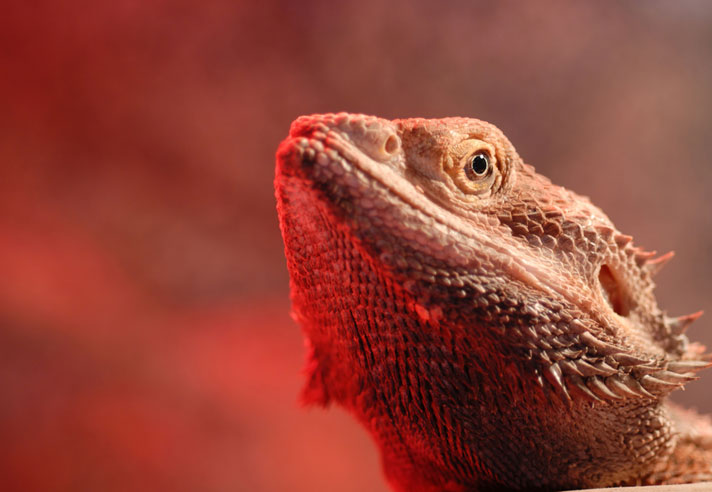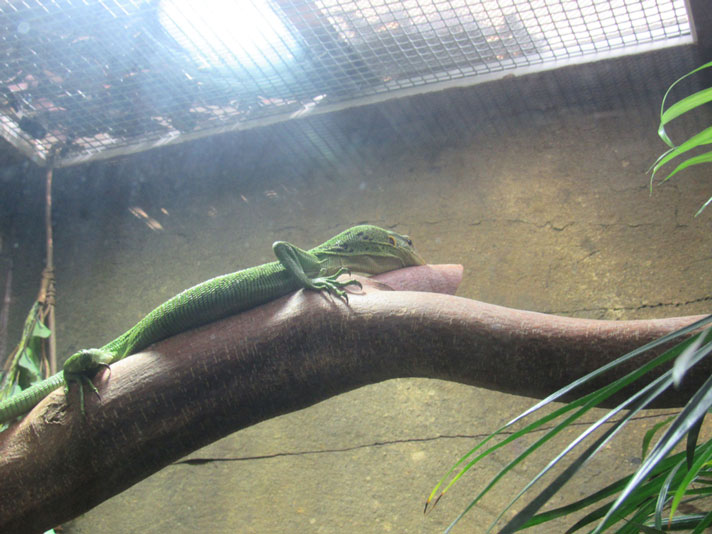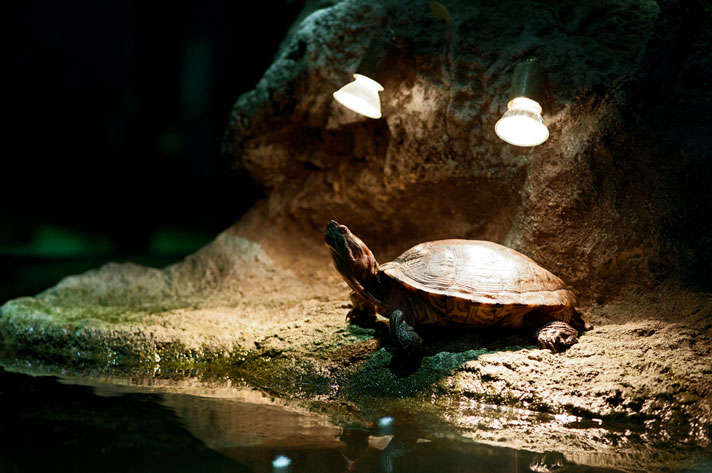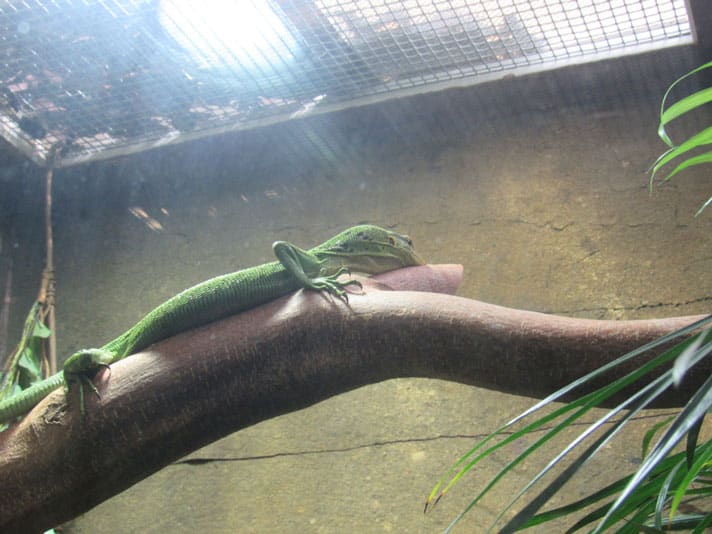Heat for reptiles isn’t just for comfort — it’s for survival.
In the wild, reptiles have just the right heat, humidity and light for their particular species — nature sees to that. But in captivity, the animals rely on us for these essentials.
As keepers of these amazing animals, it’s our responsibility to provide everything our pets needs to thrive. One of the most important essentials is heat.
Unlike mammals, which can generate their own body heat, reptiles are ectothermic; they obtain their body temperature from the environment. In the wild, reptiles choose areas to dwell based on the temperature. If they need warmth, they will move to a sunny area. If they need to cool down, they will find shade or burrow into the ground.

Gilles DeCruyenaere/Shutterstock
Supplemental heat is required if you’re going to keep desert species, including bearded dragons.
Heat is particularly important for reptiles. As with all animals, it’s necessary for a reptile to be able to move its muscles to catch prey or run from danger, and to digest its food. Heat is also important for reptiles to be able to reproduce, efficiently circulate their blood, and maintain a healthy immune system. The trade-off is that ectothermic animals like reptiles don’t require as much energy, and can more easily survive without food longer than endothermic (warm-blooded) animals.
The amount of heat a reptile needs depends on the species. Reptiles from the desert (including popular pet species such as bearded dragons and leopard geckos) and tropics (such as anoles, green iguanas and Chinese water dragons) need more warmth than a reptile from a temperate area (among them, skinks and corn snakes). While all reptiles need a warm environment, the desert and tropical reptiles are happiest when they can bask in higher temperatures than their cousins from more temperate climes.
Reptile Heating Solutions
If you want your reptile to live a long, healthy life, you’ll need to provide an environment that most closely matches conditions in the animal’s natural setting. Your terrarium should be a microcosm of that natural world, in every possible way, and heat is a crucial part of that environment.
The way you provide heat to your pets is important. In nature, reptiles move around within their environment to warmer and cooler spots, depending on how much heat they need at a given time. Your reptile needs to be able to adjust its position inside the terrarium in the same way, seeking heat when needed and cooling off, as well.

Isabel Eve/Shutterstock
Along with desert reptiles, tropical types, such as green tree monitors, must be provided with abundant heat.
Setting up your pet’s terrarium so the temperature gradually decreases away from one end to the other will allow your reptile to move to the best temperature zone for its needs. You create this environment by putting a heat source on one side of the enclosure. This area will stay warmer while the rest of the terrarium remains gradually cooler. Remember, too, that in nature, temperatures drop at night. Adjust the heating situation in the enclosure so the ambient temperature is cooler at night than it is during the day, but still within the proper range for your species.
Another important aspect of providing heat to your reptile is monitoring the actual temperature. You need to do more than just include a heat source in the terrarium; you need to make sure the temperature is where it’s supposed to be.
A variety of terrarium thermometers are available on the market. The most popular are adhesive thermometer strips that attach to the outside of the terrarium; digital thermometers with probes, which measure the temperature using a probe placed inside the terrarium; and temperature guns, which allow you to take the terrarium’s temperature at any given moment, including in specific places (which can be especially useful when checking the temperature in basking hotspots).
The simplest way to monitor the terrarium’s temperature is to place an adhesive temperature strip at each end of the enclosure. This will give you a good sense of what the temperature is in the warmest and coolest ends of the terrarium. You can then extrapolate the temperature ranges in-between the two. You can also use digital thermometers with probes for this same purpose.
If your reptile comes from a tropical climate and also needs humidity in addition to heat, you can purchase a dual thermometer and humidity gauge. This device will help you know when to increase the humidity in your reptile’s cage.
Reptile keepers who are serious about controlling the exact temperature in their pets’ cages can also add a rheostat to their heating devices. Functioning much like a dimmer switch on a light, a rheostat allows you to control the intensity of your heat source. This device can be particularly valuable if your heat source is creating too much heat for your terrarium. The rheostat essentially enables you to “lower the volume” on your heating device.
Knowing the ideal temperature for your particular species of reptile is mandatory if you are to provide a properly heated environment. Research your species thoroughly to find out the ideal upper and lower temperature ranges for your animal, and strive to create these in its terrarium. Keep in mind that the type of substrate you use, the location of the terrarium in your home, and the number and type of decorations inside the enclosure will affect the temperature.
Heat Monitoring App
Imagine being able to monitor your reptile’s terrarium temperature and humidity levels when you’re not home. If you own a smartphone, tablet or computer, then you can do just that, thanks to an app called La Crosse Alerts Mobile Reptile Guardian Temp and Humidity Monitoring System.
The app allows you to check in with your terrarium to find out the ambient temperature and humidity levels, and the surface temperature of your reptile’s hotspot. It works by reading the information provided by a probe placed in your terrarium. The app also notifies you if there’s a power outage, either by email or text. For more information, visit the Lacrosse Technology website.
Heat Sources For Your Reptile
Manufacturers of reptile products offer reptile owners a variety of heating devices from which to choose. The type you provide your reptile should depend on the animal’s needs, your individual preferences and your budget. Avoid selecting a device that will overheat your terrarium, and read the product packaging to determine if the product is appropriate for your enclosure’s size. Also, to prevent your reptile from being burned, be careful to place the heat source in an area of the terrarium where your pet can’t come into direct contact with it.
Following are the most commonly available heating products for use with reptile terrariums.
Heat pads and panels. These come in different sizes and heating strengths. Many are designed to adhere to the bottom or sides of a terrarium, and all work by emanating heat through the floor or wall. Many reptile keepers place heat pads on the bottom of the enclosure so the substrate above them becomes warm; heat panels can be attached to the ceiling of the enclosure to radiant heat downward, as well.
Heat pads and panels provide a warm area in the terrarium where reptiles can remain if they need to increase their body temperature. They should be placed on one end of the terrarium, which will allow the far opposite side of the terrarium to remain cooler. It’s usually a good idea to place a hiding place, such as a cave, on the substrate that’s being warmed.
One benefit to using heat panels and pads is that they can be left on 24 hours a day, providing a constant source of heat for your reptiles. They can also function as the sole source of heat for reptiles that don’t require a basking light. The drawback of some heating pads that use adhesive to attach to an enclosure is that they can’t be removed once they have been affixed.
When using a heat pad beneath the enclosure, be sure to raise the enclosure so air is able to circulate beneath it. This will help keep the pad from overheating the terrarium and, in the case of a glass terrarium, possibly cracking the bottom glass. As with all devices, be sure to read and follow manufacturer instructions for the best outcome.
Radiant heat lamp. These lamps are a good choice for reptiles that like to bask. There are both halogen and incandescent radiant heat lamps. Halogen lamps are often used in terrariums where high humidity is important because such lamps are less likely to dry out the air. Incandescent heat lamps are inexpensive and can produce a lot of heat, depending on their wattage.

Olha UkhaShutterstock
Depending on the type of reptile you keep and how you want to heat its enclosure, you can choose from a number of different types of radiant heat lamps.
Depending on the type of reptile you keep and how you want to heat its enclosure, you can choose from a number of different types of radiant heat lamps:
- Ceramic heat emitters produce infrared heat, and so can be used for 24 hours without disrupting a reptile’s nocturnal activity. Made from porcelain, they screw into a socket, often also porcelain (rather than aluminum, such as those found in some dome fixtures). Ceramic heat emitters are popular in high-humidity terrariums because they are less drying than standard incandescent bulbs.
- Nighttime incandescent basking bulbs create heat without light, and are good at increasing the ambient temperature of the terrarium. Because they do not emit light, they don’t disturb reptiles’ day and night cycles.
- Red heat lamps emit infrared heat waves along with a soft, red glow that allows you to observe your reptile’s nighttime activities without disturbing your pet. This type of lamp can be used at all times of the day to produce heat, not just at night.
- Daylight bulbs provide reptiles with heat along with the ultraviolet wavelengths that reptiles need for to produce vitamin D3, which is vital to metabolizing calcium. Incandescent daylight bulbs produced specifically for reptiles have been modified to reduce the yellow light that normally emanates from a regular incandescent bulb. This prevents the bulb from changing the color of the animal to the human eye. When choosing a daylight bulb, remember that those with a higher wattage will produce more heat. Follow manufacturer recommendations as to which bulbs to use for what type and size of enclosure.
- Spotlight basking bulbs direct heat and UV light downward onto a smaller, specific area by using a tighter beam. This hotspot is where basking reptiles will usually gather. These lights also work well to warm the end of the terrarium in which they’re placed.
Mercury vapor lamps are one of the newer heating products on the market, and they have the benefit of providing both important UVB rays as well as heat. They fit in incandescent light fixtures.
Unlike other types of heat lamps, mercury vapor lamps cannot be used with a rheostat, so it’s important to get the proper wattage for your terrarium. They can also be fragile, so handle them carefully and, as usual, follow the instructions on their packaging to use them properly.
Sold by the foot, heat tape affixes to the outside of the enclosure, much like a heat pad. In order to work, the heat tape has to be attached to a wire clip insulator set that plugs into a wall outlet. The tape and wire clip are often sold together.
Heat tape should be used with a thermostat to regulate how much heat is delivered into the terrarium. No more than one-third of the tank bottom should be covered with heat tape to allow a gradual decrease in heat across the terrarium. The downside of using heat tape versus a heat pad is that you have to adhere it yourself because it does not have a sticky side like a heat pad does. The advantage, though, is that you can remove it and use it on another terrarium.
Heating cable is a flexible, water-resistant insulated cable that emanates heat when plugged in. Heat cables come in different lengths to accommodate different sizes of terrariums. They can be placed in the terrarium in large loops or tight coils, depending on how much heat you wish to provide.
Heat cables can be placed inside the terrarium, wrapped around a wood accessory, placed in a hollow limb or attached to the outside of the terrarium using electrical tape. Because heat cables are water resistant, they are often a good choice for high-humidity enclosures.
Because they are flexible, heat cables can be arranged in a way that provides an effective heat gradient within the terrarium. They can also be plugged into a thermostat for a more accurate way of controlling temperature.
Remember that proper heating is one of the most important aspects of successful reptile keeping. By consistently providing your reptile with the proper temperature range for its species, you’ll be providing a crucial piece of the puzzle required to create a healthy and comfortable environment for your pet.
Audrey Pavia is a freelance writer specializing in animal subjects and the author of The Gecko: An Owner’s Guide to a Happy Healthy Pet (Howell Book House). She has kept a number of reptile species, including leopard geckos and California desert tortoises.



